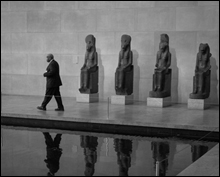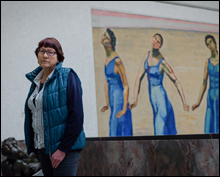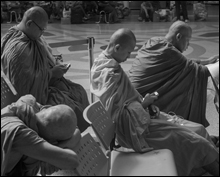
|
|
|
Featured Artist: Adam MarelliAdam Marelli didn't set out to teach photographers the principles of design that have been the common language of Western art for 2,000 years. It just happened naturally, after he opened his studio in Manhattan."Teaching art or photography has been a byproduct of running a studio for centuries," Marelli says. Artists trained assistants who became artists in their own right. It was through this one-on-one, mentoring method that artists customarily learned their craft. Michelangelo, Da Vinci, Rembrandt, any master painter or sculptor you care to name, began as an apprentice and had apprentices of their own. It's this method that Marelli employs with a growing number of photographers who attend his workshops and visit his website. At 33, Marelli— artist, sculptor, draftsman, builder, photographer— has begun to make a name for himself, both through his art and photography, and his approach to teaching. He is the resident photographer at Leica Akademie in New York City. He recently won honorable mention in the 2013 International Photography Awards competition for "Lost Ceremony," his series on traditional Japanese craftsmen. His photos and writing have appeared in the New York Times, Forbes and GQ, among others. He began his education in the conventional, 20th Century manner. He graduated from New York University with a B.S. and a dual concentration in sculpture and architecture. But somehow, his education didn't all hang together. "I knew I didn't want to be an architect, yet I saw architectural influences in artists that I admired. I also knew that if I stood something I built next to something a professional built, it would not stand up," he says. So he continued his education, honing skills he practiced in college and learning the myriad things you can't learn from books, through the age-old, system of apprenticeships and mentoring. Just out of NYU, he spent ten years doing high-end residential work as apprentice to his first mentor, a master builder. In the same spirit, Marelli studied with Zen monks for seven years. (His abiding interest in mentoring and apprenticeships is reflected in several series of photos on his website, including the "Lost Ceremony" series, his "OnSite" and his photos of the gondola workshops of Roberto Tramontin and Squero di San Trovaso in Venice.) Later, he met and studied with the man he considers his second mentor, long-time artist and teacher Myron Barnstone who for decades has been teaching artists the design principles that comprise our visual language in a traditional, atelier setting. "My approach when I don't know how to do something has been that I am going to find the very best person I can and I'm going to learn from them," Marelli says. Reflecting on his mentors, Marelli realized they shared a certain teaching style. They do the work, demonstrate how the pieces of the discipline come together and answer student questions. They are open-handed with their knowledge. Most important, they show how to do their craft in a broader context that imbues the work with meaning. It's this context–the unchanging design principles that structure all the visual arts–and the sense of purpose that goes along with understanding them that Marelli wants to convey to photographers. "Without a purpose, [art, photography] is just mechanics and it isn't fulfilling. But if you can connect what you're doing to a history and understand what artists have been doing for thousands of years, then you can really put something out in the world," he says. Our common visual language consists of just five simple marks, Marelli explains on his website: the point, the horizontal line, the vertical line, the diagonal and the curve or arc. The principles of design are the framework for using these marks effectively. Understanding and using this visual language of design distinguishes the artist from the amateur or hobbyist, Marelli says on his website. "An artist is someone who works within the visual language, expressing a knowledge and dexterity with its forms and symbols. There are no limitations to its form of expression, but an artist must be conversant in the visual language and not simply use its devices in arbitrary means and methods." Marelli illustrates the visual language and how it has been used by masters from Da Vinci to Cartier-Bresson and by contemporary photographers such as Steve McCurry and Sebastiao Salgado. He serves up lessons from art history and from his personal interaction with workshop participants. There is practically no talk about camera gear. Some of the most interesting material on the site are the "de-constructions" of famous photos and painting to reveal their structural underpinnings. Marelli chooses to keep his workshops small, never more than ten participants, to foster the one-on-one relationships that are the heart of mentoring. The groups are a relaxed mix of lectures, photography, critique and discussion punctuated by frequent stops in cafes and communal meals. This year, Marelli has taken groups to Bangkok, Zurich, Matera, Italy, Venice, London and New York City. In 2014, workshop destinations will include Chiangmai, Thailand and Berlin, plus return-trips to London, Matera, Venice and New York. He's also started single-day photo seminars and one-on-one instruction via phone or in person. "The visual language is truly accessible to anyone, but it needs to be passed from one person to the next. There is no single text or even a canon of books that will make you entirely fluent in it," he says. "I liked to draw as a child. We could say I had an inclination towards art. But I was not an artist. Only by working for years in studios, classes, workshops (the kind of workshops where you build things), and through personal mentoring did I become fluent in the visual language," Marelli explains. "You don't have to study for years to be a draftsman to use the language," he adds. "The camera takes care of reproduction, but it needs an intelligent eye to guide it to success." Adam Marelli is intent on helping photographers develop that eye. Visit Adam Marelli's website devoted to photography and design at: www.adammarelliphoto.com. You can see examples of his sculpture and drawing, as well as photography at www.adammarelli.com. |
All photos this page © Adam Marelli 
 |

| |||
Copyright ©  AutumnColor Digital Imaging AutumnColor Digital Imaging | | 70 Webster Street 70 Webster Street | | Worcester, MA 01603 Worcester, MA 01603 | | Toll Free: 800-533-5050 Toll Free: 800-533-5050 | | Fax: 508-757-2216 Fax: 508-757-2216
|
|||



